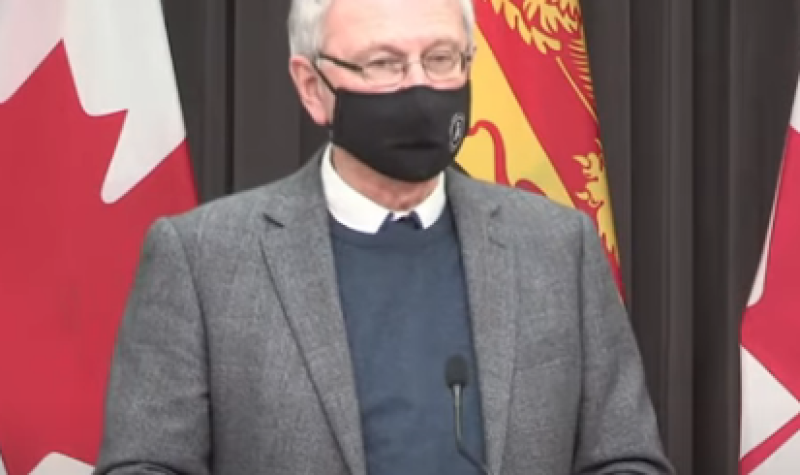As of midnight Tuesday night, zone one is now under the red phase of COVID-19 restrictions.
Chief Medical Officer of Health Jennifer Russell made the announcement yesterday, along with two other health zones including the Saint John and Fredericton regions.
Hear the NB COVID-19 update re-cap on Tantramar Report:
“More than half of our province, from Claire to Aulac will be under red alert level of restrictions,” said Russell on Tuesday.
“These zones include our three largest cities, and many of our largest employers. These zones are where the majority of New Brunswickers live and work. This recommendation is not made lightly,” said Russell. “I know there will be consequences both intended and unintended. These restrictions will undoubtedly cause concern and hardship for many New Brunswickers, but these actions are absolutely necessary if we are to avoid the avalanche of cases being experienced just beyond our borders.”
For details on what the red phase means for you, click here.
By the numbers
Russell announced 31 new cases of COVID-19 in the province yesterday:
- Zone 1 (Southeast/Moncton): 4 new cases
- Zone 2 (Saint John region): 3 new cases
- Zone 3 (Fredericton region): 1 new cases
- Zone 4 (Edmundston region): 21 new cases
- Zone 5 (Campbellton region): 1 new cases
- Zone 6 (Bathurst region): 1 new case
- Zone 7 (Mirimachi region): 0 new cases
Russell also announced another death of a patient with COVID-19. A resident of Parkland Saint John died with the disease, bringing the total deaths in the province to 13.
The total active cases in New Brunswick is now 316, and one person is in hospital.
There are 73 active cases of COVID-19 in Zone 1, the southeast region.
'Getting close to calling in community transmission'
Russell said that the number of cases in Zones 1, 2 and 3 has been growing at an alarming rate, doubling twice in the past two weeks.
“In each of these zones, we have seen at least three distinct chains of infection that have spread beyond their original source,” said Russell. “Only one of the clusters now being investigated can definitely be linked to an infection that occurred outside of New Brunswick. So we call those unlinked chains of transmission. So we’re getting close to calling it community transmission at this point.”
Russell said spread happened during gatherings over the holidays, but has continued since then, even under orange phase restrictions.
“Many of these cases were spread through large social gatherings including card parties, celebrations and holiday gatherings around Christmas and New Year’s,” said Russell. “But subsequent to the orange phase alert levels we have still continued to see transmission, in workplace settings, in schools, where people have not been wearing masks, or where they have gone to places with symptoms and have not been tested.”
Russell said they have also seen cases in people returning from out of province travel who failed to self isolate properly.
Part of Russell’s remarks Tuesday were geared towards inevitable criticisms that the red phase might not be necessary in New Brunswick.
“Despite all the evidence that decisive action is needed, there will be doubters and skeptics,” said Russell. “There will be those who will compare our case numbers with those seen in Ontario, Quebec, Maine and Alberta and say we are not as badly off as they are. And to them, I say: Yes, and we don’t want to be. There are those who will note that we have only a handful of cases in hospital and declare that our healthcare system is not overwhelmed. And to them, I say: Not yet. There are those who will point out that we have only seen a dozen deaths from COVID-19 in 10 months. And to them, I say: Thankfully, yes. How many more would you like to see?”
Premier Blaine Higgs also spoke on Tuesday, asking New Brunswickers to buckle down to help stem the growth of cases, citing an unprecedented situation, even in an unprecedented time.
“We have never been in a situation like this since the pandemic began,” said Higgs. “We’ve never had so many cases. We’ve never been surrounded by such record high numbers of cases to the north and to the west. We do not yet know if new strains of COVID-19 are present in New Brunswick, but they pose an additional real threat. And that’s something we must also take into account with the actions that we’re taking today.”
Increased access to testing?
CHMA asked Russell if and when smaller communities could expect better access to testing. Without providing specifics, Russell said that new testing sites are imminent for two rural communities, and planned for two more.
“We do hear from the public that it is problematic in terms of driving to certain locations depending on the distance,” said Russell. So there are two communities that we’re going to add right now. And we’re looking at two other communities to help boost people’s desire and ease for testing, in the coming days.”



